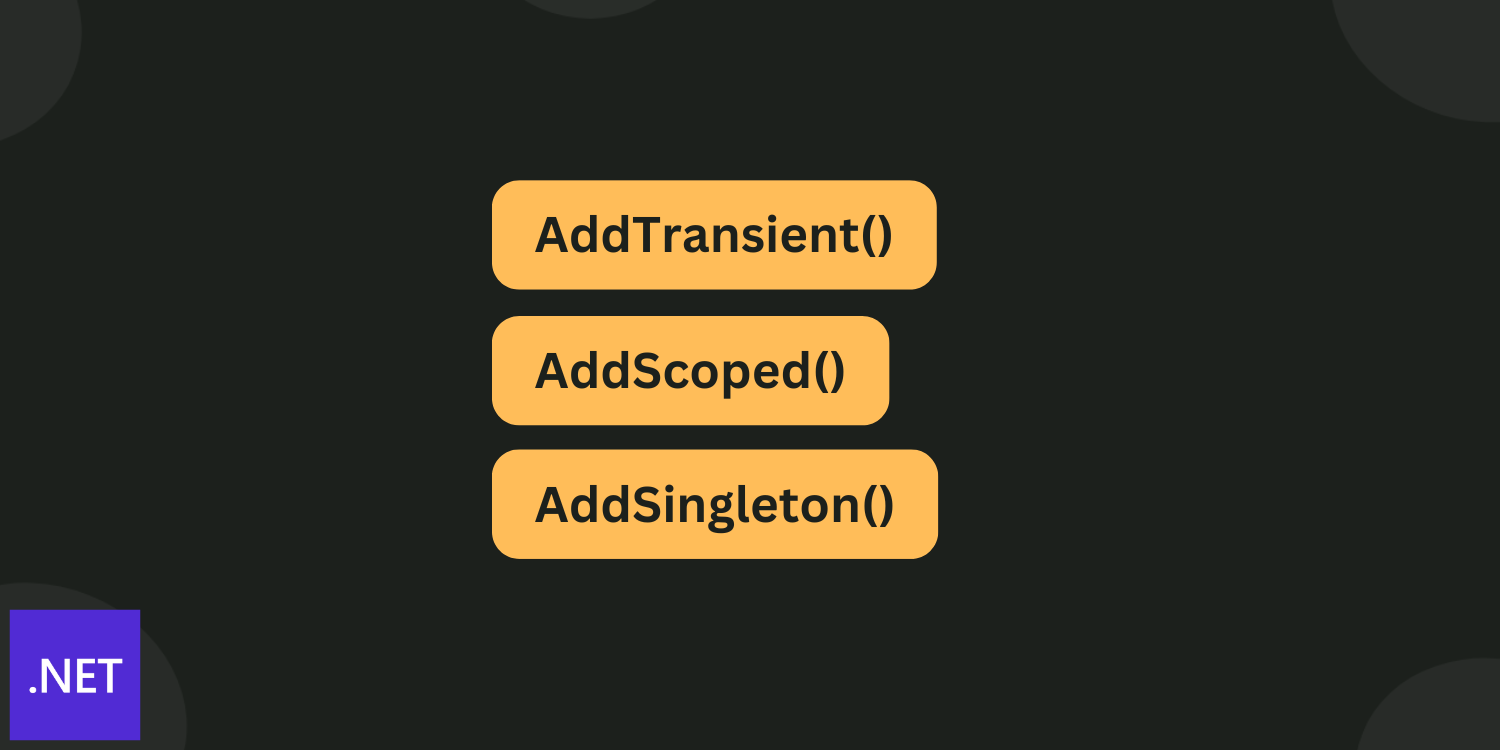
Example Setup
I am using a MinimalApi application. Create a new one if you need.
dotnet new webapi -n DITest
Open it in a IDE or editor of your choice.
public interface IMyService
{
Guid InstanceId { get; }
}
public class MyService : IMyService
{
public Guid InstanceId { get; }
public MyService()
{
InstanceId = Guid.NewGuid();
// We are logging in the constructor, so that we get notified whenever the instance is created
Console.WriteLine($"==> Service created with InstanceId: {InstanceId}");
}
}
IMyService have a read-only property named InstanceId of type Guid, which is set from the constructor.
We are logging inside the constructor, so that we can get notified whenever the new instance is created.
Creating a middleware
We are creating a middleware, where we request for the instance of the serive and log the instance id to the console.
app.Use(async (context, next) =>
{
var scopedService = context.RequestServices.GetRequiredService<IMyService>();
Console.WriteLine($"Middleware - InstanceId: {scopedService.InstanceId}");
await next(context);
});
Create an endpoint
app.MapGet("/test", (IMyService service1,IServiceProvider serviceProvider) =>
{
var service2 = serviceProvider.GetRequiredService<IMyService>();
Console.WriteLine($"At endpoint- InstanceId1:{service1.InstanceId}");
Console.WriteLine($"At endpoint- InstanceId2:{service2.InstanceId}");
return Results.Ok(new
{
InstanceId1 = service1.InstanceId,
InstanceId2= service2.InstanceId
});
});
📢 At how many places we are requesting for the instance of IMyService?
At 3 places.
- Once at middleware
- Twice at
/testendpoint
AddTransient
Let’s register our service as transient.
builder.Services.AddTransient<IMyService, MyService>();
Let’s run the application and hit the endpoint {baseUrl}/test.
Open the console and you will notice these logs:
==> Service created with InstanceId: 486bc64a-b0d4-4216-9b36-3ca97b7fa5cd
Middleware - InstanceId: 486bc64a-b0d4-4216-9b36-3ca97b7fa5cd
==> Service created with InstanceId: 93021022-6d9f-4243-867b-454d09825dcf
==> Service created with InstanceId: 8ea09c7f-955c-44c3-b684-4cc14ac873ca
At endpoint- InstanceId1:93021022-6d9f-4243-867b-454d09825dcf
At endpoint- InstanceId2:8ea09c7f-955c-44c3-b684-4cc14ac873ca
Each time we are requesting for the service, we are getting a new instance. Exactly 3 instances in one http request : 1 for the middleware and 2 for the endpoints.
AddScoped
builder.Services.AddScoped<IMyService, MyService>();
Let’s run the application and hit the endpoint {baseUrl}/test.
==> Service created with InstanceId: 58f6af3f-cdd7-44be-bb11-65653d958848
Middleware - InstanceId: 58f6af3f-cdd7-44be-bb11-65653d958848
At endpoint- InstanceId1:58f6af3f-cdd7-44be-bb11-65653d958848
At endpoint- InstanceId2:58f6af3f-cdd7-44be-bb11-65653d958848
Let’s hit the endpoint {baseUrl}/test one more time.
## this log is from the previous request
==> Service created with InstanceId: 58f6af3f-cdd7-44be-bb11-65653d958848
Middleware - InstanceId: 58f6af3f-cdd7-44be-bb11-65653d958848
At endpoint- InstanceId1:58f6af3f-cdd7-44be-bb11-65653d958848
At endpoint- InstanceId2:58f6af3f-cdd7-44be-bb11-65653d958848
## this log is from the current request
==> Service created with InstanceId: 1d53377b-2ac0-4388-84bf-8adaf0bf9db1
Middleware - InstanceId: 1d53377b-2ac0-4388-84bf-8adaf0bf9db1
At endpoint- InstanceId1:1d53377b-2ac0-4388-84bf-8adaf0bf9db1
At endpoint- InstanceId2:1d53377b-2ac0-4388-84bf-8adaf0bf9db1
As you have noticed, the instance of IMyService is created once per http request and reused.
📢 When using entity framework core, AddDbContext registers DbContext type with scoped lifetime by default.
AddSingleton
builder.Services.AddSingleton<IMyService, MyService>();
Let’s run the application and hit the endpoint {baseUrl}/test.
==> Service created with InstanceId: 7d80f0bb-110c-4bc4-ac72-4f6f0f7ee2fd
Middleware - InstanceId: 7d80f0bb-110c-4bc4-ac72-4f6f0f7ee2fd
At endpoint- InstanceId1:7d80f0bb-110c-4bc4-ac72-4f6f0f7ee2fd
At endpoint- InstanceId2:7d80f0bb-110c-4bc4-ac72-4f6f0f7ee2fd
Let’s hit the endpoint {baseUrl}/test one more time.
## req 1
==> Service created with InstanceId: 7d80f0bb-110c-4bc4-ac72-4f6f0f7ee2fd
Middleware - InstanceId: 7d80f0bb-110c-4bc4-ac72-4f6f0f7ee2fd
At endpoint- InstanceId1:7d80f0bb-110c-4bc4-ac72-4f6f0f7ee2fd
At endpoint- InstanceId2:7d80f0bb-110c-4bc4-ac72-4f6f0f7ee2fd
## req 1
Middleware - InstanceId: 7d80f0bb-110c-4bc4-ac72-4f6f0f7ee2fd
At endpoint- InstanceId1:7d80f0bb-110c-4bc4-ac72-4f6f0f7ee2fd
At endpoint- InstanceId2:7d80f0bb-110c-4bc4-ac72-4f6f0f7ee2fd
As you have noticed, instance of the IMyService is created once and shared with subsequent requests.
Summary
AddTransient: Instance is created each time when the service is requested.
AddScoped : Instance is created once per scope (or http request) and shared across the scope. In the case of web apis, scope is equivalent to http request.
AddSingleton : Instance is created once per application lifetime and shared across the application lifetime.